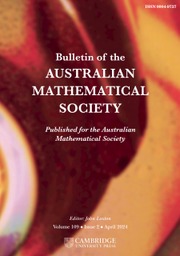No CrossRef data available.
Article contents
ON ADDITIVE COMPLEMENTS IN THE COMPLEMENT OF A SET OF NATURAL NUMBERS
Published online by Cambridge University Press: 07 November 2025
Abstract
Let A be a set of natural numbers. A set B of natural numbers is an additive complement of the set A if all sufficiently large natural numbers can be represented in the form  $x+y$, where
$x+y$, where  $x\in A$ and
$x\in A$ and  $y\in B$. We establish that if
$y\in B$. We establish that if  $A=\{a_i: i\in \mathbb {N}\}$ is a set of natural numbers such that
$A=\{a_i: i\in \mathbb {N}\}$ is a set of natural numbers such that  $a_i<a_{i+1} $ for
$a_i<a_{i+1} $ for  $i \in \mathbb {N}$ and
$i \in \mathbb {N}$ and  $\liminf _{n\rightarrow \infty } (a_{n+1}/a_{n})>1$, then there exists a set
$\liminf _{n\rightarrow \infty } (a_{n+1}/a_{n})>1$, then there exists a set  $B\subset \mathbb {N}$ such that
$B\subset \mathbb {N}$ such that  $B\cap A = \varnothing $ and B is a sparse additive complement of the set A.
$B\cap A = \varnothing $ and B is a sparse additive complement of the set A.
MSC classification
Information
- Type
- Research Article
- Information
- Copyright
- © The Author(s), 2025. Published by Cambridge University Press on behalf of Australian Mathematical Publishing Association Inc
References
Chen, Y.-G. and Fang, J.-H., ‘Additive complements of the squares’, J. Number Theory 180 (2017), 410–422.10.1016/j.jnt.2017.04.016CrossRefGoogle Scholar
Dai, L.-X. and Pan, H., ‘The additive complements of primes and Goldbach’s problem’, Acta Arith. 162(3) (2014), 209–221.10.4064/aa162-3-1CrossRefGoogle Scholar
Ding, Y., ‘Green’s problem on additive complements of the squares’, C. R. Math. Acad. Sci. Paris 358(8) (2020), 897–900.10.5802/crmath.107CrossRefGoogle Scholar
Erdős, P., ‘Some results on additive number theory’, Proc. Amer. Math. Soc. 5(6) (1954), 847–853.10.1090/S0002-9939-1954-0064798-9CrossRefGoogle Scholar
Faisant, A., Grekos, G., Panday, R. K. and Somu, S. T., ‘Additive complements for a given asymptotic density’, Mediterr. J. Math. 18(1) (2021), 1–13.10.1007/s00009-020-01679-0CrossRefGoogle Scholar
Fang, J.-H. and Sándor, C., ‘Additive completion of thin sets’, Bull. Aust. Math. Soc. 109(3) (2024), 429–436.10.1017/S0004972723001016CrossRefGoogle Scholar
Grekos, G., Pandey, R. K. and Somu, S. T., ‘Sumsets with prescribed lower and upper asymptotic densities’, Mediterr. J. Math. 19(5) (2022), 1–9.10.1007/s00009-022-02139-7CrossRefGoogle Scholar
Kolountzakis, M. N., ‘On the additive complements of the primes and sets of similar growth’, Acta Arith. 77(1) (1996), 1–8.10.4064/aa-77-1-1-8CrossRefGoogle Scholar
Leonetti, P. and Tringali, S., ‘On the density of sumsets’, Monatsh. Math. 198(3) (2022), 565–580.10.1007/s00605-022-01694-1CrossRefGoogle Scholar
Leonetti, P. and Tringali, S., ‘On the density of sumsets II’, Bull. Aust. Math. Soc. 109(3) (2024), 414–419.10.1017/S000497272300062XCrossRefGoogle Scholar
Lorentz, G. G., ‘On a problem of additive number theory’, Proc. Amer. Math. Soc. 5(5) (1954), 838–841.10.1090/S0002-9939-1954-0063389-3CrossRefGoogle Scholar
Mohan, , Patil, B. R. and Pandey, R. K., ‘On additive complement with special structures’, Mediterr. J. Math. 22 (2025), Article no. 57.10.1007/s00009-025-02825-2CrossRefGoogle Scholar
Ruzsa, I., ‘Additive completion of lacunary sequences’, Combinatorica 21 (2001), 279–291.10.1007/s004930100025CrossRefGoogle Scholar


